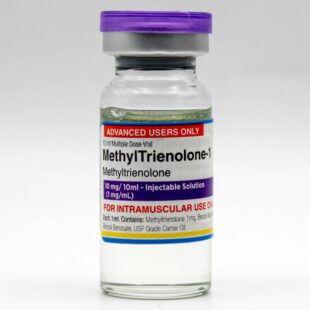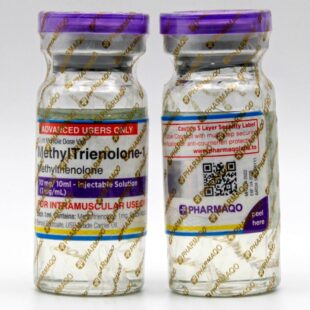- Your cart is empty
- Continue Shopping

- Home
- Buy Online Steroids
- Injectable Steroids
- Methyltrienolone
Methyltrienolone
Methyltrienolone is a powerful anabolic steroid known for its exceptional strength and fat loss properties. As a derivative of nandrolone, it offers high anabolic effects without the risk of estrogenic side effects, making it appealing to bodybuilders and athletes. Methyltrienolone is characterized by its inability to aromatize, resulting in hard, defined muscle gains. It is commonly used during cutting cycles to preserve lean muscle while enhancing overall performance. Its potent nature necessitates careful dosing, as it can yield significant results even at low amounts.
Active Substance: Methyltrienolone (Metribolone, R1881)
Commercial Names: Metribolone, R1881, RU-1881, Methyltrienolone
Steroid Class: Extreme Potency/Research Compound (Not recommended for general use)
Dosage: 0.5-2mg daily (Extremely hepatotoxic – medical supervision essential)
Comprehensive Overview
Methyltrienolone, scientifically known as Metribolone or R1881, represents one of the most potent anabolic-androgenic steroids ever synthesized, demonstrating 120-300 times the oral anabolic potency and 60-70 times the androgenic potency of methyltestosterone in research studies. This synthetic estrane steroid is a 17α-alkylated derivative of trenbolone, featuring exceptional binding affinity for androgen receptors while maintaining virtually no estrogenic activity.
The compound’s extraordinary potency stems from its unique chemical structure – 17α-methyltrenbolone – which provides exceptional metabolic stability and receptor binding characteristics. Unlike conventional anabolic steroids, Methyltrienolone demonstrates significant affinity for multiple steroid receptors, including progesterone receptors (208% relative to progesterone), androgen receptors (204% relative to testosterone), and mineralocorticoid receptors (18% relative to aldosterone).
Methyltrienolone’s primary significance lies in scientific research applications, where it serves as the gold standard ligand for androgen receptor binding assays and photoaffinity labeling studies. However, its extreme hepatotoxic potential, observed even at doses as low as 0.1-1.0mg daily, prevented its approval for medical use and makes it one of the most dangerous compounds in existence.
The compound’s 17α-alkylation provides oral bioavailability but contributes to its exceptional liver toxicity, with severe hepatic dysfunction documented in clinical trials for breast cancer treatment, leading to immediate discontinuation of development.
Historical Background & Development
Methyltrienolone was first synthesized and described in scientific literature in 1965, representing a significant advancement in anabolic steroid research and development. Initially developed as part of efforts to create more potent therapeutic agents for muscle wasting conditions and hormone-responsive cancers, the compound quickly demonstrated unprecedented anabolic activity in laboratory settings.
Clinical investigations began in the late 1960s and early 1970s, focusing primarily on treatment of advanced breast cancer in women. Despite showing therapeutic efficacy and relatively weak androgenic effects, researchers observed severe signs of hepatotoxicity at extremely low dosages, with liver dysfunction occurring at doses considered minimal for other anabolic compounds.
The compound’s development for medical applications was permanently discontinued due to its unacceptable hepatotoxic profile, with researchers concluding that no therapeutic dose could be established safely. However, by the mid-1970s, Methyltrienolone found new purpose in scientific research as the preferred ligand for androgen receptor studies.
Its adoption as a research standard occurred because of its exceptional receptor binding characteristics and stability, making it invaluable for understanding androgen receptor function and developing new therapeutic compounds. Today, it remains widely used in legitimate scientific research while being encountered occasionally in illicit performance enhancement contexts.
Why Bodybuilders Choose Methyltrienolone
Bodybuilders gravitate toward Methyltrienolone despite its extreme risks due to its unparalleled anabolic potency, with some users seeking the ultimate strength and muscle-building compound regardless of health consequences. The compound’s reputation as the most potent oral anabolic steroid available creates appeal among hardcore users willing to accept extreme risks for maximum results.
The compound’s complete lack of aromatization eliminates estrogen-related side effects, providing dry, lean muscle gains without water retention or gynecomastia concerns. This characteristic makes it particularly attractive for competitive bodybuilders seeking maximum muscle density and definition without estrogenic complications.
Users report dramatic strength increases within days of initiation, with some experiencing strength gains that surpass all other available compounds. The compound’s ability to enhance protein synthesis and nitrogen retention at extremely low doses appeals to those seeking maximum anabolic effects with minimal injection volume.
Professional competitors occasionally utilize Methyltrienolone during final contest preparation phases, believing its extreme potency provides competitive advantages that outweigh the substantial health risks. However, this usage represents extremely dangerous practices that have resulted in serious health complications.
Unique Benefits for Bodybuilders
Methyltrienolone delivers several distinctive advantages that distinguish it from all other anabolic compounds, primarily centered around its extraordinary potency requiring minimal dosages. The compound’s ability to produce significant anabolic effects with doses measured in milligrams rather than hundreds of milligrams appeals to users seeking maximum efficiency.
The complete absence of estrogenic activity eliminates needs for aromatase inhibitors while ensuring lean, dry muscle gains without water retention. This characteristic provides predictable physique enhancement without the bloating or softness associated with aromatizing compounds.
Enhanced recovery and training capacity occur rapidly, with users reporting ability to train with higher intensity and frequency within days of initiation. The compound’s potent androgen receptor activation translates to dramatic improvements in strength, power output, and muscle fiber recruitment.
Unlike injectable trenbolone, the oral nature of Methyltrienolone provides convenience and eliminates injection site complications, though this advantage comes with severe hepatotoxic consequences. The compound’s stability and potency mean users can achieve effects with minimal volume and frequency.
Benefits & Applications
Methyltrienolone excels in promoting rapid strength gains and muscle hardness, with users typically experiencing dramatic improvements within 3-5 days of initiation. The compound’s exceptional androgen receptor binding creates anabolic environments that surpass virtually all other available options.
Enhanced nitrogen retention and protein synthesis occur at levels that exceed other potent compounds, supporting accelerated muscle tissue development and recovery. Users report ability to maintain high training intensity throughout cycles while experiencing reduced fatigue and enhanced performance capacity.
The compound’s anti-catabolic properties provide muscle preservation during severe caloric restriction, making it valuable for competitive preparation phases where muscle retention is crucial. Additionally, its lack of water retention ensures that strength and size gains represent quality muscle tissue rather than temporary fluid accumulation.
Research applications demonstrate the compound’s value in understanding androgen receptor function and developing new therapeutic agents, though these uses remain strictly within controlled laboratory environments. The compound’s stability and receptor affinity make it irreplaceable for certain scientific investigations.
Usage Guidelines
Methyltrienolone dosing protocols require extreme caution, with effective doses typically ranging from 0.5-2mg daily, though even these minimal amounts carry substantial hepatotoxic risks. Due to severe liver toxicity observed at doses as low as 0.1mg daily in clinical studies, any usage represents significant health risks.
Cycle durations must be kept extremely short, typically 2-4 weeks maximum, to minimize liver damage and other severe complications. The compound’s potency means longer cycles are unnecessary and dramatically increase health risks without proportional benefits.
Stacking with other compounds is generally discouraged due to Methyltrienolone’s extreme potency and toxicity profile, though some advanced users combine it with testosterone bases at minimal doses. Any combination protocols exponentially increase health risks and require constant medical monitoring.
Liver protection protocols including N-acetylcysteine, milk thistle, and TUDCA are essential but may not provide adequate protection against the compound’s severe hepatotoxic potential. Regular blood work monitoring liver enzymes, lipid profiles, and other health markers is mandatory throughout any usage period.
Safety Considerations
Methyltrienolone presents extreme safety concerns that surpass virtually all other anabolic compounds, with severe hepatotoxicity representing the primary and most dangerous risk. Clinical studies documented liver dysfunction at doses considered minimal, with some subjects experiencing serious hepatic complications requiring immediate discontinuation.
Cardiovascular risks include potential impacts on cholesterol profiles, blood pressure, and cardiac function, though liver toxicity typically presents more immediate dangers. The compound’s effects on reproductive system function include severe suppression of natural testosterone production and potential fertility complications.
Additional reported adverse effects include increased risk of thrombosis and myocardial infarction, making the compound unsuitable for individuals with any cardiovascular predisposition. The compound’s potent androgenic effects can cause accelerated male pattern baldness, severe acne, and other androgenic complications.
Long-term health consequences remain largely unknown due to limited human studies, though animal research suggests potential for permanent organ damage with extended exposure. Post-cycle therapy protocols must be aggressive and comprehensive to address the severe hormonal suppression caused by the compound.
Frequently Asked Questions
Q: Is Methyltrienolone safe for any level of user?
A: No, Methyltrienolone was never approved for human use due to severe hepatotoxicity observed even at minimal doses. Clinical trials were discontinued due to unacceptable liver damage risks.
Q: How does Methyltrienolone compare to other oral steroids in terms of liver toxicity?
A: Methyltrienolone demonstrates exceptional hepatotoxic potential that exceeds other oral steroids by significant margins, with liver dysfunction observed at doses far lower than other compounds.
Q: Why is Methyltrienolone used in scientific research if it’s so dangerous?
A: Its exceptional androgen receptor binding affinity and stability make it invaluable for research applications, but these studies occur in controlled laboratory environments with proper safety protocols.
Q: Can liver protection supplements make Methyltrienolone safe?
A: No supplement protocol can adequately protect against Methyltrienolone’s severe hepatotoxic potential. Even pharmaceutical-grade liver protection may be insufficient given the compound’s extreme toxicity profile.







